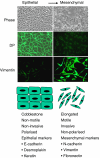Desmosomes: a role in cancer?
- PMID: 17519903
- PMCID: PMC2359958
- DOI: 10.1038/sj.bjc.6603808
Desmosomes: a role in cancer?
Abstract
Much evidence now attests to the importance of desmosomes and their constituents in cancer. Alterations in the expression of desmosomal components could contribute to the progression of the disease by modifying intracellular signal transduction pathways and/or by causing reduced cell adhesion. The Wnt/beta-catenin pathway is a potential target because of the involvement of the cytoplasmic desmosomal protein plakoglobin. Loss of desmosomal adhesion is a prerequisite for the epithelial-mesenchymal transition, implicated in the conversion of early stage tumours to invasive cancers.
Figures


References
-
- Aberle H, Bierkamp C, Torchard D, Serova O, Wagner T, Natt E, Wirsching J, Heidkamper C, Montagna M, Lynch HT, Lenoir GM, Scherer G, Feunteun J, Kemler R (1995) The human plakoglobin gene localizes on chromosome 17q21 and is subjected to loss of heterozygosity in breast and ovarian cancers. Proc Natl Acad Sci USA 92: 6384–6388 - PMC - PubMed
-
- Aigner K, Descovich L, Mikula M, Sultan A, Dampier B, Bonne S, van Roy F, Mikulits W, Schreiber M, Brabletz T, Sommergruber W, Schweifer N, Wernitznig A, Beug H, Foisner R, Eger A (2007) The transcription factor ZEB1 (deltaEF1) represses Plakophilin 3 during human cancer progression. FEBS Lett 581: 1617–1624 - PMC - PubMed
-
- Biedermann K, Vogelsang H, Becker I, Plaschke S, Siewert JR, Hofler H, Keller G (2005) Desmoglein 2 is expressed abnormally rather than mutated in familial and sporadic gastric cancer. J Pathol 207: 199–206 - PubMed
-
- Brennan D, Hu Y, Joubeh S, Choi YW, Whitaker-Menezes D, O'Brien T, Uitto J, Rodeck U, Mahoney MG (2007) Suprabasal Dsg2 expression in transgenic mouse skin confers a hyperproliferative and apoptosis-resistant phenotype to keratinocytes. J Cell Sci 120: 758–771 - PubMed
-
- Canes D, Chiang GJ, Billmeyer BR, Austin CA, Kosakowski M, Rieger-Christ KM, Libertino JA, Summerhayes IC (2005) Histone deacetylase inhibitors upregulate plakoglobin expression in bladder carcinoma cells and display antineoplastic activity in vitro and in vivo. Int J Cancer 113: 841–848 - PubMed
Publication types
MeSH terms
Substances
LinkOut - more resources
Full Text Sources

